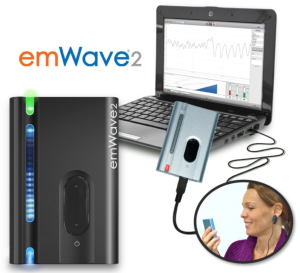During the Connected Health Symposium last week, I noticed a significant trend that I have since been calling the “next big thing for the quantified self movement”. What is the next big thing in a world dominated by fitness trackers and mobile apps? That next big thing is biofeedback. I gained access to quite a few innovators while at the conference. They note that while clinicians have been using biofeedback for eons in order to understand any number of things about a human body, most of those tools do not come in a patient-friendly package. Thanks to these innovators, now they do. Here are four examples quantified self devices that use biofeedback to help patients understand and manage their health.
Choose Muse
It is hard to make brain data real to a patient. As a result, up until now there has been virtually nothing a person can do to improve  their brain health. Psychoanalysis is highly stigmatized, which causes an even bigger drift to form between patients and cognitive health. In order to fix this, clinicians have created a consumer friendly, clinical grade EEG to provide patients with their first real contact with their brain. The device is called Muse, and it is being dubbed “the brain sensing headband”.
their brain health. Psychoanalysis is highly stigmatized, which causes an even bigger drift to form between patients and cognitive health. In order to fix this, clinicians have created a consumer friendly, clinical grade EEG to provide patients with their first real contact with their brain. The device is called Muse, and it is being dubbed “the brain sensing headband”.
By using the device, patient can improve their cognitive functions and see their outcomes in real time. This device has also shown promising in the treatment of depression and other mental illness. Since this treatment is wrapped in the quantitative self trend, it does not receive the same reluctance that stigmatized psychoanalysis does. This provides promising new treatment options.
HeartMath
During the Connected Health Symposium, it was noted that 75% of physician visits are stress related. Patients are often made to feel that they ar e “stuck with it” and there is nothing that can be done. However, a really neat connection between the heart and the brain can be used, through the power of feedback, to manage stress related illnesses such as heart disease.
e “stuck with it” and there is nothing that can be done. However, a really neat connection between the heart and the brain can be used, through the power of feedback, to manage stress related illnesses such as heart disease.
I’m not sure if you knew this, but there is a “brain” in the heart that senses and responds to emotions and communicates through nerves to the brain. This heart-brain communication provides us with a way to manage our stress and get heart healthy through the use of biofeedback. Using biofeedback through tools like HeartMath, patients can gain windows into their hearts and brains to self manage their stress response. While this is certainly empowering for prevention of heart disease, heart disease patients have been studied, and have improved outcomes through using the HeartMath biofeedback system.
Stay tuned for an upcoming experiment that is set to merge the Muse and HeartMath technologies.
Sensoree
 If you work in healthcare technology, and you go to a Connected Health Symposium, then you will get your fair share of interesting conference performances. In one such performance, we were introduced to Sensoree, which is a company that creates wearable technology that show visually, through light displays, what the individual wearing the technology is feeling. This proves incredibly helpful for patients with Autism and Alzheimer’s that do not have the ability to communicate their emotional states readily. Sensoree introduced these technologies by having circus performers wear them during an acrobatic dance routine. As they danced, you could see their emotional states changing as a red glow of nervousness as the performers began turned into a blue glow of of focus to a purple glow of bliss.
If you work in healthcare technology, and you go to a Connected Health Symposium, then you will get your fair share of interesting conference performances. In one such performance, we were introduced to Sensoree, which is a company that creates wearable technology that show visually, through light displays, what the individual wearing the technology is feeling. This proves incredibly helpful for patients with Autism and Alzheimer’s that do not have the ability to communicate their emotional states readily. Sensoree introduced these technologies by having circus performers wear them during an acrobatic dance routine. As they danced, you could see their emotional states changing as a red glow of nervousness as the performers began turned into a blue glow of of focus to a purple glow of bliss.
BioBeats
This last bit, called BioBeats, is a platform for merging entertainment with healthcare. In one very compelling move, BioBeats partnered with music crew Far East Movement in an attempt to connect millions of listeners to their health by way of mobile phone enabled heart beat sensors. As Far East Movement performed, they encouraged their fans to record their hard beats. By the time the song was over, they had collected over 1.5 million heartbeats that were, in real time, transformed into the beat that lived in the background of their performance. Check out this “Turn Up The Love” performance below.
